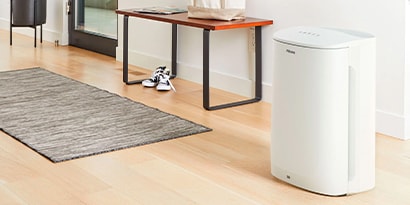-
Cats vs. Dogs: Which Is Easier on Air Quality?
-
Being a cat person or a dog person really comes down to personal preference. But let’s bypass opinions on loyalty, intelligence and even general cuddliness for a moment. How does living with canines or felines affect the air your family breathes? And how do they compare?
Facts about pet allergens
The root cause of pet allergies
Contrary to popularly held belief, cat or dog hair are not allergens. It’s actually a combination of pet dander—tiny flecks of shed skin—and proteins found in the animal’s saliva, urine and feces. When pets groom themselves, the saliva dries and eventually flakes off into the air.
Those tiny particles float around your home and settle on furniture, bedding and other fabrics.
The difference between cat allergies and dog allergies
All dogs and cats, regardless of size or breed, are sending potentially problematic particles into the air. But it’s what those particles are actually made of that differs. The commonly allergenic proteins a dog deposits are called the Can f I and Can f II, and in cats, it’s the Fel d I¹.
Much like the animals that produce them, these proteins behave differently. The feline Fel d I is smaller, lighter and stickier than the Can f canine proteins. What does this mean for you? Basically, feline proteins linger longer in the air and more easily cling to furniture and fabrics.
And the award for most allergenic pet goes to …
That’s right: cats. In fact, cat allergies are about twice as common as dog allergies, according to the Asthma and Allergy Foundation of America (AAFA).²
But let’s be honest. The love cat and dog owners feel for their pets tends to outweigh any allergens they might carry. So whether you have a cat or dog, here are some tips to better tame the annoying, sneeze-inducing side effects of your favorite furry friend².
Tips to help combat pet allergies
Wash up
Ideally, you’d wash your pets once or twice a week. If that’s too frequent, at least wash your own hands and face regularly, especially right after cuddling your pet. And when you do bathe him or her, you may want to try a dander-reducing shampoo. Ask your vet for recommendations.
Declare the bedroom a pet-free zone
Since we typically spend at least one-third of our time in the bedroom, it’s a good idea to try and make this your allergen-free oasis. Clean the room and wash your sheets at least once a week. The AAFA recommends adding a HEPA air purifier to the room as well.
Brush or comb your pet regularly
It’s best done outside a few times a week. Try to assign this grooming task to someone without a pet allergy. If that isn’t possible, break out the dust mask. Same goes for changing the litter box.
Clean and pick up
Make both strict habits. The more often you declutter, vacuum, dust and wipe down walls (yes, walls) and other surfaces, the less time sticky dander has to build up. To truly trap allergens, rather than simply agitating them, use a vacuum with a HEPA filter or a disposable electrostatic bag. The AAFA also recommends steam-cleaning carpets regularly.
Use an allergen-capturing air filter
When changed regularly (at minimum, every three months) air filters can capture visible and invisible dander and other allergens, effectively vacuuming the air that flows through the filter.
Consider the whole environment
If you’re battling dust mites, cigarette smoke, mold or pollen, your allergies have possibly already kicked in, making you extra sensitive if adding a pet to the mix. To lessen your overall reaction, do what you can to reduce exposure to all problem allergens.
Get medical help
Over-the-counter antihistamines or prescription allergy medications may help. Perhaps prescription allergy medication would better treat your symptoms. Immunotherapy (aka allergy shots), a multi-year process that can potentially rid you of your cat allergies or dog allergies altogether, is another possible option. Talk to your doctor.
Sources:
-



